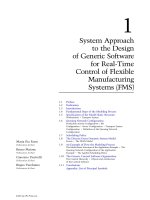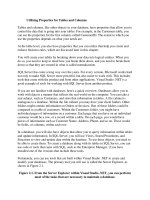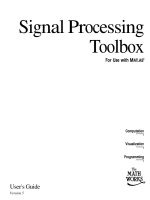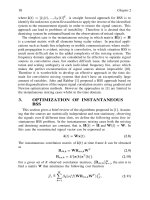Tài liệu SIGNAL PROCESSING FOR TELECOMMUNICATIONS AND MULTIMEDIA MULTIMEDIA docx
Bạn đang xem bản rút gọn của tài liệu. Xem và tải ngay bản đầy đủ của tài liệu tại đây (11.35 MB, 302 trang )
SIGNAL PROCESSING FOR
TELECOMMUNICATIONS
AND MULTIMEDIA
MULTIMEDIA SYSTEMS AND
APPLICATIONS SERIES
Consulting Editor
Borko Furht
Florida Atlantic University
Recently Published Titles:
ADVANCED WIRED AND WIRELESS NETWORKS edited by Tadeusz A. Wysocki, Arek
Dadej and Beata J. Wysocki; ISBN: 0-387-22847-0; e-ISBN: 0-387-22928-0
CONTENT-BASED VIDEO RETRIEVAL: A Database Perspective by Milan Petkovic and
Willem Jonker; ISBN: 1-4020-7617-7
MASTERING E-BUSINESS INFRASTRUCTURE, edited by Veljko Frédéric
Patricelli; ISBN: 1-4020-7413-1
SHAPE ANALYSIS AND RETRIEVAL OF MULTIMEDIA OBJECTS by Maytham H.
Safar and Cyrus Shahabi; ISBN: 1-4020-7252-X
MULTIMEDIA MINING: A Highway to Intelligent Multimedia Documents edited by
Chabane Djeraba; ISBN: 1-4020-7247-3
CONTENT-BASED IMAGE AND VIDEO RETRIEVAL by Oge Marques and Borko Furht;
ISBN: 1-4020-7004-7
ELECTRONIC BUSINESS AND EDUCATION: Recent Advances in Internet
Infrastructures, edited by Wendy Chin, Frédéric Patricelli, Veljko ISBN: 0-
7923-7508-4
INFRASTRUCTURE FOR ELECTRONIC BUSINESS ON THE INTERNET by Veljko
ISBN: 0-7923-7384-7
DELIVERING MPEG-4 BASED AUDIO-VISUAL SERVICES by Hari Kalva; ISBN: 0-
7923-7255-7
CODING AND MODULATION FOR DIGITAL TELEVISION by Gordon Drury, Garegin
Markarian, Keith Pickavance; ISBN: 0-7923-7969-1
CELLULAR AUTOMATA TRANSFORMS: Theory and Applications in Multimedia
Compression, Encryption, and Modeling, by Olu Lafe; ISBN: 0-7923-7857-1
COMPUTED SYNCHRONIZATION FOR MULTIMEDIA APPLICATIONS, by Charles
B. Owen and Fillia Makedon; ISBN: 0-7923-8565-9
STILL IMAGE COMPRESSION ON PARALLEL COMPUTER ARCHITECTURES by
Savitri Bevinakoppa; ISBN: 0-7923-8322-2
INTERACTIVE VIDEO-ON-DEMAND SYSTEMS: Resource Management and
Scheduling Strategies, by T. P. Jimmy To and Babak Hamidzadeh; ISBN: 0-7923-8320-6
MULTIMEDIA TECHNOLOGIES AND APPLICATIONS FOR THE 21st CENTURY:
Visions of World Experts, by Borko Furht; ISBN: 0-7923-8074-6
SIGNAL PROCESSING FOR
TELECOMMUNICATIONS
AND MULTIMEDIA
edited by
Tadeusz A. Wysocki
University of Wollongong, Australia
Bahram Honary
Lancaster University, UK
Beata J. Wysocki
University of Wollongong, Australia
Springer
eBook ISBN: 0-387-22928-0
Print ISBN: 0-387-22847-0
Print ©2005 Springer Science + Business Media, Inc.
All rights reserved
No part of this eBook may be reproduced or transmitted in any form or by any means, electronic,
mechanical, recording, or otherwise, without written consent from the Publisher
Created in the United States of America
Boston
©2005 Springer Science + Business Media, Inc.
Visit Springer's eBookstore at:
and the Springer Global Website Online at:
CONTENTS
PART I: MULTIMEDIA SOURCE PROCESSING
1.
A Cepstrum Domain HMM-Based Speech Enhancement Method
Applied to Non-stationary Noise
2.
Time Domain Blind Separation of Nonstationary Convolutively
Mixed Signals
3.
4.
Objective Hybrid Image Quality Metric for In-Service Quality
Assessment
5.
An Object-Based Highly Scalable Image Coding for Efficient
MultimediaDistribution
6.
Classification of Video Sequences in MPEG Domain
M.Nilsson, M.Dahl, and I.Claesson
Preface
ix
I.T.Russel, J.Xi, and A.Mertins
15
1
Speech and Audio Coding Using Temporal Masking
T.S.Gunavan, E.Ambikairajah, and D.Sen
31
T.M.Kusuma, and H J.Zepernick
43
H.Danyali, and A.Mertins
57
W.Gillespie, and T.Nguyen
71
vi
PART II: ERROR-CONTROL CODING, CHANNEL
ACCESS, AND DETECTION ALGORITHMS
7.
Unequal Two-Fold Turbo Codes
8.
Code-Aided ML Joint Delay Estimation and Frame Synchronization
H.Wymeersch, and M.Moeneclaey 97
9.
Adaptive Blind Sequence Detection for Time Varying Channel
M.N.Patwary, P.Rapajic, and I.Oppermann 111
10.
Optimum PSK Signal Mapping for Multi-Phase Binary-CDMA
Systems
Y J.Seo,and Y H.Lee 125
11.
A Complex Quadraphase CCMA Approach for Mobile Networked
Systems
K. L. Brown, and M. Darnell
135
12.
Spatial Characterization of Multiple Antenna Channels
T.S.Pollock, T.D.Abhayapala, and R.A.Kennedy 145
13.
Increasing Performance of Symmetric Layered Space-Time Systems
P. Conder and T. Wysocki 159
14.
New Complex Orthogonal Space-Time Block Codes of Order Eight
J.Seberry, L.C.Tran, Y.Wang, B.J.Wysocki, T.A.Wysocki, T.Xia, and
Y.Zhao 173
PART III: HARDWARE IMPLEMENTATION
15.
Design of Antenna Array Using Dual Nested Complex
Approximation
M.Dahl, T. Tran, I. Claesson, and S.Nordebo .183
16.
Low-Cost Circularly Polarized Radial Line Slot Array Antenna for
IEEE 802.11 B/G WLAN Applications
S.Zagriatski, and M. E. Bialkowski 197
C.Tanriover, and B.Honary
87
vii
17.
Software Controlled Generator for Electromagnetic Compatibility
Evaluation
P.Gajewski, and J.Lopatka 211
18.
Unified Retiming Operations on Multidimensional Multi-Rate
Digital Signal Processing Systems
D.Peng, H.Sharif, and S.Ci 221
19.
Efficient Decision Feedback Equalisation of Nonlinear Volterra
Channels
S.Sirianunpiboon, and J.Tsimbinos 235
20.
A Wideband FPGA-Based Digital DSSS Modem
K.Harman, A.Caldow, C.Potter, J.Arnold, and G.Parker 249
21.
Antennas for 5-6 GHz Wireless Communication Systems
Y.Ge, K.P.Esselle, and T.S.Bird 269
Index 281
This page intentionally left blank
PREFACE
The unprecedented growth in the range of multimedia services offered
these days by modern telecommunication systems has been made possible
only because of the advancements in signal processing technologies and
algorithms. In the area of telecommunications, application of signal
processing allows for new generations of systems to achieve performance
close to theoretical limits, while in the area of multimedia, signal processing
the underlying technology making possible realization of such applications
that not so long ago were considered just a science fiction or were not even
dreamed about. We all learnt to adopt those achievements very quickly, but
often the research enabling their introduction takes many years and a lot of
efforts. This book presents a group of invited contributions, some of which
have been based on the papers presented at the
International Symposium
on DSP for Communication Systems held in Coolangatta on the Gold Coast,
Australia, in December 2003.
Part 1 of the book deals with applications of signal processing to
transform what we hear or see to the form that is most suitable for
transmission or storage for a future retrieval. The first three chapters in this
part are devoted to processing of speech and other audio signals. The next
two chapters consider image coding and compression, while the last chapter
of this part describes classification of video sequences in the MPEG domain.
Part 2 describes the use of signal processing for enhancing performance
of communication systems to enable the most reliable and efficient use of
those systems to support transmission of large volumes of data generated by
multimedia applications. The topics considered in this part range from error-
control coding through the advanced problems of the code division multiple
x
access (CDMA) to multiple-input multiple-output (MIMO) systems and
space-time coding.
The last part of the book contains seven chapters that present some
emerging system implementations utilizing signal processing to improve
system performance and allow for a cost reduction. The issues considered
range from antenna design and channel equalisation through multi-rate
digital signal processing to practical DSP implementation of a wideband
direct sequence spread spectrum modem.
The editors wish to thank the authors for their dedication and lot of efforts in
preparing their contributions, revising and submitting their chapters as well
as everyone else who participated in preparation of this book.
Tadeusz A. Wysocki
Bahram Honary
Beata J. Wysocki
PART 1:
MULTIMEDIA SOURCE PROCESSING
This page intentionally left blank
Chapter 1
A CEPSTRUM DOMAIN HMM-BASED SPEECH
ENHANCEMENT METHOD APPLIED TO NON-
STATIONARY NOISE
Mikael Nilsson, Mattias Dahl and Ingvar Claesson
Blekinge Institute of Technology, School of Engineering, Department of Signal Processing,
372 25 Ronneby, Sweden
Abstract: This paper presents a Hidden Markov Model (HMM)-based speech
enhancement method, aiming at reducing non-stationary noise from speech
signals. The system is based on the assumption that the speech and the noise
are additive and uncorrelated. Cepstral features are used to extract statistical
information from both the speech and the noise. A-priori statistical
information is collected from long training sequences into ergodic hidden
Markov models. Given the ergodic models for the speech and the noise, a
compensated speech-noise model is created by means of parallel model
combination, using a log-normal approximation. During the compensation, the
mean of every mixture in the speech and noise model is stored. The stored
means are then used in the enhancement process to create the most likely
speech and noise power spectral distributions using the forward algorithm
combined with mixture probability. The distributions are used to generate a
Wiener filter for every observation. The paper includes a performance
evaluation of the speech enhancer for stationary as well as non-stationary
noise environment.
Key words: HMM, PMC, speech enhancement, log-normal
1.
INTRODUCTION
Speech separation from noise, given a-priori information, can be viewed
as a subspace estimation problem. Some conventional speech enhancement
methods are spectral subtraction [1], Wiener filtering [2], blind signal
separation [3] and hidden Markov modelling [4].
Hidden Markov Model (HMM) based speech enhancement techniques
are related to the problem of performing speech recognition in noisy
2
Chapter 1
environments [5,6]. HMM based methods uses a-priori information about
both the speech and the noise [4]. Some papers propose HMM speech
enhancement techniques applied to stationary noise sources [4,7]. The
common factor for these problems is to the use of Parallel Model
Combination (PMC) to create a HMM from other HMMs. There are several
possibilities to accomplish PMC including Jacobian adaptation, fast PMC,
PCA-PMC, log-add approx-imation, log-normal approximation, numerical
integration and weighted PMC [5,6]. The features for HMM training can be
chosen in different manners. However, the cepstral features have dominated
the field of speech recognition and speech enhancement [8]. This is due to
the fact that the covariance matrix, which is a significant parameter in a
HMM, is close to diagonal for cepstral features of speech signals.
In general, the whole input-space, with the dimension determined by the
length of the feature vectors, contains the speech and noise subspaces. The
speech subspace should contain all possible sound vectors from all possible
speakers. This is of course not practical and the approximated subspace is
found by means of training samples from various speakers and by averaging
over similar speech vectors. In the same manner the noise subspace is
approximated from training samples. In non-stationary noise environments
the noise subspace complexity increases compared to a stationary subspace,
hence a larger noise HMM is needed. After reduction it is desired to obtain
only the speech subspace.
The method proposed in this paper is based on the log-normal
approximation by adjusting the mean vector and the covariance matrix.
Cepstral features are treated as observations and diagonal covariance
matrices are used for hidden Markov modeling of the speech and noise
source. The removal of the noise is performed by employing a time
dependent linear Wiener filter, continuously adapted such that the most
likely speech and noise vector is found from the a-priori information. Two
separate hidden Markov models are used to parameterize the speech and
noise sources. The algorithm is optimized for finding the speech component
in the noisy signal. The ability to reduce non-stationary noise sources is
investigated.
2.
FEATURE EXTRACTION FROM SIGNALS
The signal of concern is a discrete time noisy speech signal x(n), found
from the corresponding correctly band limited and sampled continuous
signal. It is assumed that the noisy speech signal consists of speech and
additive noise
1. HMM-Based Speech Enhancement
3
where s(n) is the speech signal and w(n) the noise signal.
The signals will be divided into overlapping blocks of length L and
windowed. The blocks will be denoted
where t is the block index and “time” denotes the domain. Note that the
additive property still holds after these operations.
The blocks are represented in the linear power spectral domain as
where
is the discrete Fourier transform matrix and D = L / 2 + 1
due to the symmetry of the Fourier transform of a real valued signal. Further,
denotes absolute value and “lin” denotes the linear power spectral domain.
In the same manner and are defined. Hence the noisy speech in
linear power spectral domain will be found as
where is a vector of angles between the individual elements in and
The cosine for these angles can be found as
The speech and the noise signal are assumed to be uncorrelated. Hence,
the cross term in Eq. (1.4) is ignored, and the approximation
is used.
Further, the power spectral domain will be transformed into the log
spectral domain
4
Chapter 1
where the natural logarithm is assumed throughout this paper and “
log
”
denotes the log spectral domain. The same operations are also applied for the
speech and the noise. Finally the log spectral domain is changed to the
cepstral domain
where
“cep”
denotes the cepstral domain and is the discrete
cosine transform matrix defined as
where i is the row index and j the column index.
3.
ERGODIC HMMS FOR SPEECH AND NOISE
Essential for model based speech enhancement approaches is to get
reliable models for the speech and/or the noise. In the proposed system the
models are found by means of training samples, which are processed to
feature vectors in the cepstral domain, as described in previous section.
These feature vectors, also called observation vectors in HMM
nomenclature, are used for training of the models. This paper uses k-means
clustering algorithm [9], with Euclidian distance measure between the
feature vectors, to create the initial parameters for the iterative expectation
maximation (EM) algorithm [10]. Since ergodic models are wanted, the
clustering algorithm divides the observation vectors into states. The
observation vectors are further divided into mixtures using the clustering
algorithm on the vectors belonging to each individual state. Using these
initial segmentation of vectors, the EM algorithm is applied and the
parameters for the HMM are found. The model parameter set for an HMM
with N states and M mixtures is
1. HMM-Based Speech Enhancement
5
where contains the initial state probabilities, the state
transitions probabilities and the
parameters for the weighted continuous multidimensional Gaussian
functions for state j and mixture k. For an observation, the continuous
multidimensional Gaussian function for state j and mixture k, is
found as
where D is the dimension of the observation vector, is the mean vector
and is the covariance matrix. The covariance matrix is in this paper
chosen to be diagonal. This implies that the number of parameters in the
model is reduced and the computable cost of the matrix inversion is reduced.
The weighted multidimensional Gaussian function for an observation
is defined as
where is the mixture weight.
4.
ERGODIC HMM FOR NOISY SPEECH USING
PARALLEL MODEL COMBINATION
Given the trained models for speech and noise, a combined noisy-speech-
model can be found by PMC where and are the model
parameters for the speech and the noise HMM respectively and denotes
the operations needed to create the composite model.
This paper uses a non-iterative model combination and log-normal
approximation to create the composite model parameters for the noisy
speech. The compensation for the initial state is found as
6
Chapter 1
In the same manner the transition probabilities, are given by
where the state [
iu] represents the noisy speech state found by clean speech
state i and the noisy state u, and similar for [
iu].
The compensated mixture weights are found as
where [kl] is the noisy speech mixture given the clean speech mixture k and
the noise mixture l.
Since the models are trained in the cepstral domain, the mean vector and
the covariance matrix are also in cepstral domain. Hence the mean vector
and the covariance matrix in Eq. (1.11) are in the cepstral domain. Since the
uncorrelated noise is additive only in the linear spectral domain,
transformations of the multivariate Gaussian distribution are needed. These
transformations are applied both for the clean speech model and the noise
model. The first step is to transform the mean vectors and the covariance
matrices from cepstral domain into the log spectral domain (the indices for
state j and mixture k are dropped for simplicity)
Equation (1.16) is the standard procedure for linear transformation of a
multivariate Gaussian variable. Equation (1.17) defines the relationship
between the log spectral domain and the linear spectral domain for a
multivariate Gaussian variable
6
where m and n are indices in the mean vector and the Gaussian covariance
matrix for state j and mixture k. Now the parameters for the clean speech and
the noise are found in the linear spectral domain. The mean vectors for the
speech and the noise in linear spectral domain are stored to be used in the
1. HMM-Based Speech Enhancement
7
enhancement process. In Eq. (1.17) it can be seen that the linear spectral
domain is log-normal distributed. Given the assumption that the sum of two
log-normal distributed variables are log-normal distributed, the distorted
speech parameters can be found as
where g is a gain term introduced for signal to noise discrepancies between
training and enhancement environment. The noise parameters are
subsequently inverse transformed to the cepstral domain. This is done by
first inverting Eq. (1.17)
and then transform the log spectral domain expression into the cepstral
domain
yielding all parameters are found for the compensated model.
5.
CLEAN SPEECH SIGNAL ESTIMATION
The enhancement process, see Fig. 1-1, uses information gained from
training of speech and noise models to estimate the clean speech signal. The
information needed are the stored mean vectors in linear spectral domain,
and for the speech and the noise respectively, the compensated
8
Chapter 1
model, and the gain difference, g, between training and enhancement
environment.
The stored mean vectors are first restored from length D to the full
block length, L, according to
where m = 1,2, , L is the index in the full length vector, which can be
interpreted as an unfolding operation of the result from Eq. (1.3). The
vectors, and are the prototypes for power spectral densities of clean
speech and noise respectively.
Given the compensated model the scaled forward variable,
can be found by employing the scaled forward algorithm [10]. The scaled
forward variable yields the probability vector for being in state j for an
observation at time t. Given the scaled variable and the mixture weights, it is
possible to find the probability of being in state j and mixture k at
observation time t
where in this case, are the mixture weights for the compensated model.
Given the probability and the spectral prototypes, the most probable,
according to the models, clean speech vector and noise vector at observation
time t can be found by calculating the average for all states and mixtures
1. HMM-Based Speech Enhancement
9
Figure 1-1. The enhancement process.
10
Chapter 1
where a determines whether magnitude (a = 1) or power spectrum (a = 2)
is used. Given the most likely clean speech and noise vector, a linear Wiener
filter
is created.
In order to control the noise reduction a noise reduction limit, can
be selected in the interval [0,1]. The floor is applied for the filter vector at
every observation time and is defined as
where m = 1,2, ,L is the index in the full length filter at observation time
t.
A filter is applied to the L-point fast Fourier transform, of
followed by the filtering and the inverse fast Fourier transform, of
the filtered signal.
Given the filtered blocks, the discrete time enhanced speech signal,
y(n), is reconstructed using conventional overlap-add [11].
6.
EXPERIMENTAL RESULTS
In this section the proposed speech enhancer is evaluated on both
stationary and non-stationary noise. During the training phase the speech and
the noise signals are divided and windowed (Hamming) into 50%
overlapping blocks of 64 samples. The ergodic speech model used is trained
on all sentences from district one in the TIMIT database [12] (380 sentences
from both female and male speakers sampled at the rate 16 kHz). The speech
model consists of N = 5 states and M = 5 mixtures.
The stationary noise is recorded in a car, and is modeled by N = 1 state
and M = 1 mixture.
1. HMM-Based Speech Enhancement
11
The non-stationary noise source is a machine gun noise from NOISEX-
92 database [13]. This noise is modeled with N = 3 states and M = 2
mixtures.
Given the trained speech and noisy model the enhancement is performed
using a = 1, i.e. a filter created in the magnitude domain with the noise
reduction limit set to Here the floor is given in decibel
scale (dB-scale). The speech signals during enhancement were selected from
the testing set of the TIMIT database. Note that the evaluation sentences are
not included in the training phase.
The speech enhancement evaluation of stationary noise contaminated
speech can be found in Fig. 1-2.
Figure 1-2. Clean speech - s(n), car noise - w(n), noisy speech - x(n) and enhanced speech -
y(n) using proposed HMM method.
In this particular case the signal to noise ratio is improved from -5 dB to
10.8 dB. The signal to noise ratio is calculated for the whole sequence.
The result of reducing such a powerful intermittent noise source, such as
machine gun noise, can be found in Fig. 1-3. In the non-stationary noise
source case, the signal to noise ratio is calculated for the whole sequence.
The calculated SNR before and after was -5 dB and 9.3 dB, respectively.
12
Chapter 1
Figure 1-3. Clean speech - s(n), machine gun noise - w(n), noisy speech - x(n) and enhanced
speech - y(n) using proposed HMM method.
7.
CONCLUSIONS
This paper presents a cepstral-domain HMM-based speech enhancement
method. The method is based on a-priori information gathered from both the
speech and the noise source. Given the a-priori information, which is
collected in ergodic HMMs, a state dependent Wiener filter is created at
every observation. Parameters for the Wiener filter can be chosen to control
the filtering process. The proposed speech enhancement method is able to
reduce non-stationary noise sources. In enhancement problems, where
speech is degraded by an impulsive noise source, such as a machine gun
noise, the proposed method is found to substantially reduce the influence of
the noise.









